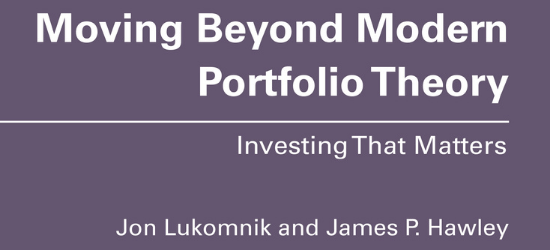The definition of what it means to invest is changing, according to Jon Lukomnik and James P. Hawley, which means examining the limitations of the 75-year old legacy of modern portfolio theory.
It’s difficult to spot a paradigm shift while it happens, but we believe the definition of what it means to invest is changing. Increasingly, investors are acting to affect the feedback loops between the real society and economy where value is created, and the capital markets, where it is priced.
Evidence is everywhere.
Environmental and social proxy resolutions in the United States are racking up numbers never seen before. The PRI has pushed its members to look at stewardship in terms of systemic risks. Money is flowing into ESG- and sustainability-themed products. We read of investor-led efforts to mitigate real world risks to the environmental, social, and financial systems virtually daily. Investors are tackling issues as disparate as climate change, fair taxation policies, income inequality, gender and racial discrimination, anti-microbial resistance, deforestation, biodiversity, and the governance of technology as well as traditional governance concerns like executive compensation.
Even regulators around the world are contributing: The chair of the Securities and Exchange Commission in the US has said he anticipates rule-making on climate and human capital management issues; the European Union has published its disclosure regulations on “green” funds and is working on its dual materiality framework; and the UK stewardship code asks asset managers about systemic risk. Even the nature of who is a regulator is changing: In the UK the chief markets regulator just hired the most high-profile head of stewardship in the country, Sacha Sadan, to helm its ESG efforts.
All this is a welcome refutation and reversal of the 75-year old legacy of modern portfolio theory (MPT) that suggests investors focus only on trading and portfolio construction.
MPT is brilliant in providing the maths to diversify and therefore extract the most efficient risk/return portfolio from the extant market but provides no tool or theory to improve the market’s return.
Yet diversification only works on idiosyncratic risks, whereas overall market movements – non-diversifiable systematic risk – determines 75 – 94 per cent of return, depending on which academic study you want to cite. This is the MPT paradox: MPT provides a powerful tool to affect that which matters least.
The result has been the development of a self-referential school of investing. Returns are relative, benchmarked against market indices divorced from real world needs of investors.
If the market is down 10 per cent, and your account is only down 8 per cent, your portfolio manager is a star, despite the fact that you have less money to fund retirement, buy a home, or whatever.
Risk is similarly siloed. To MPT, risk is volatility, and the cause of the volatility (often systemic risk in the real world that becomes non-diversifiable systematic risk in the capital markets) is irrelevant.
Academic theories have facilitated this imaginary, self-contained world: By assuming 1) rational investors, 2) efficient markets, and 3) random walk theory, MPT does away any need to deal with the messy feedback loops to the real world. Together, they create the perfect myth. They enable the math. They are easy to understand. They are explanatory. They are wrong.
Fortunately, practitioners increasingly reject the paradox.
Think of it this way: If the market itself were a portfolio, investors are trying to improve its Sharpe ratio by mitigating risks to the real world’s financial, social and environmental systems before those risks enter the capital markets. And, at last, theory is finally catching up to practice.
Three years ago, we wrote a paper that foreshadowed these arguments. It was controversial, to say the least. But in just the month of April, three important publications have examined various aspects of these issues and progressed the arguments for investors seeking to mitigate real-world risks, rather than just moving electronic dots on a trading terminal.
Bill Burkart and Steve Lydenberg’s 21stCentury Investing shows investors how to think about systems, the Predistribution Inititative’s “ESG 2.0” paper looks at the impact of institutional investors and investment structures on various ESG issues, and our book, “Moving Beyond Modern Portfolio Theory” provides the first coherent finance theory of why investors confront the MPT paradox.
When paradigms shift, they can shift quickly.
Jon Lukomnik and James P. Hawley are co-authors of Moving Beyond Modern Portfolio Theory: Investing That Matters” (Routledge, 2021)



